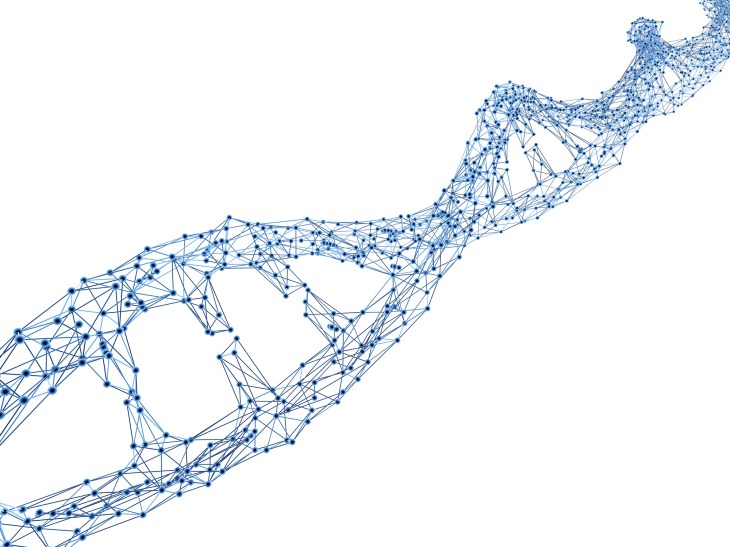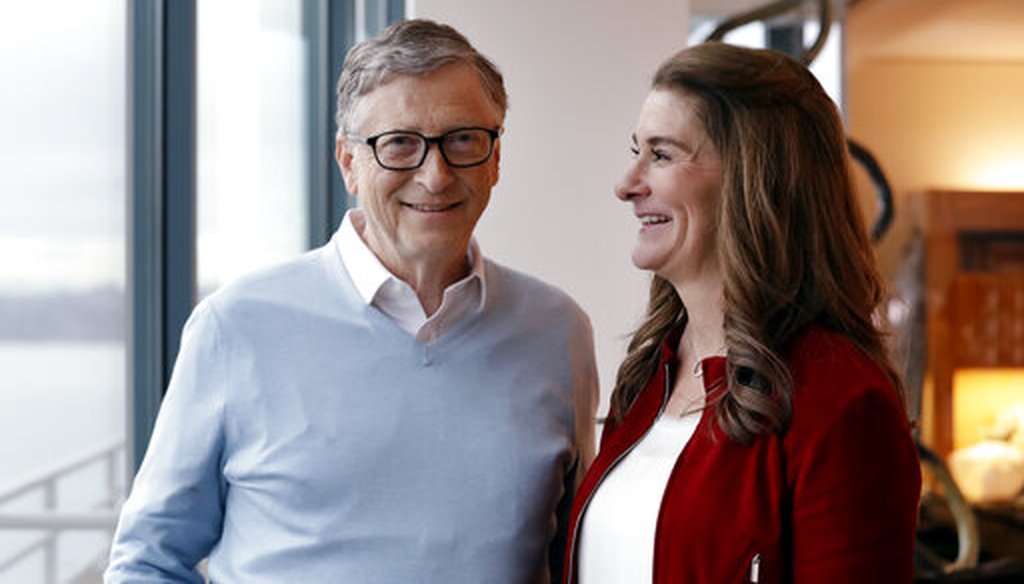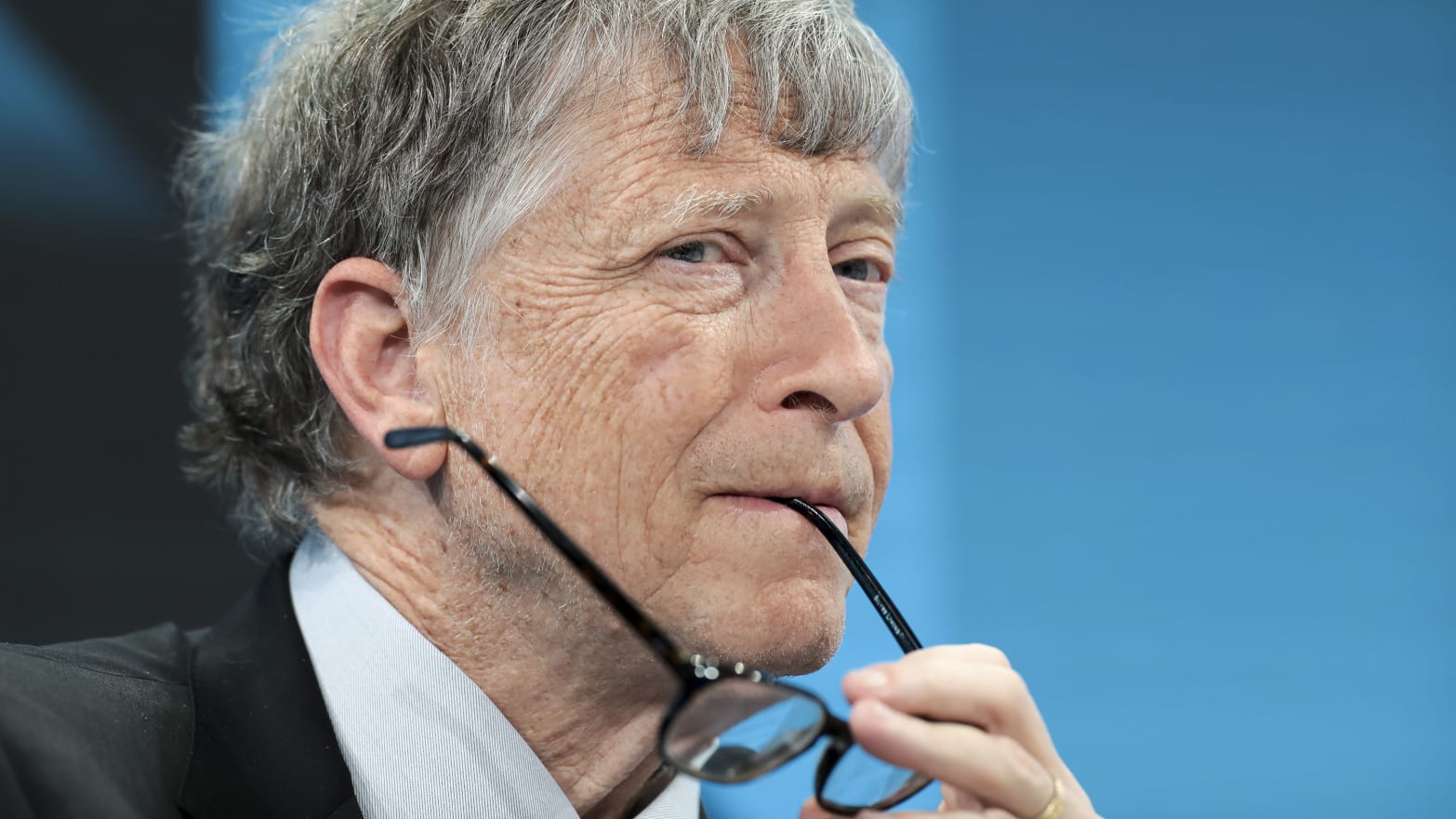Do your own research and let me know what you think. This article should provide a great jumping off point for your study. I pray that the Holy Spirit will lead you to ALL TRUTH.

Summaries of health policy coverage from major news organizations
MONDAY, APR 6 2020
THE WALL STREET JOURNAL
Bill Gates to Help Fund Coronavirus-Vaccine Development
Foundation along with governments and other backers to develop facilities for most-promising efforts

Microsoft Corp. co-founder Bill Gates said his foundation will make billions of dollars available for manufacturing the most promising vaccines to combat the novel coronavirus.
Mr. Gates, a billionaire philanthropist who is one the richest people in the world, said the Bill and Melinda Gates Foundation will work with seven makers of a possible vaccine to develop facilities and manufacture doses.

Image Credits: Alfred Pasieka/Science Photo Library (opens in a new window)/ Getty Images
A new COVID-19 vaccine candidate is entering Phase 1 clinical human testing today, after the U.S. Food and Drug Administration (FDA) accepted an application from Inovio Pharmaceuticals under the regulator’s Investigational New Drug program. Inovio plans to inject its first volunteer test subject with the INO-4800 DNA vaccine candidate it has developed, following promising results from preclinical studies performed on animals that did indicate increased immune response.
The Inovio DNA vaccine candidate works by injecting a specifically engineered plasmid (a small, independent genetic structure) into a patient so that their cells can produce a desired, targeted antibody to fight off a specific infection. DNA vaccines, while available and approved for a variety of animal infections in veterinary medicine, have not yet been approved for human use. (Did you catch that? So, they are not only using this virus to accelerate vaccine approval without proper testing, but they are ramrodding the use of DNA material in vaccines which has not been tested or approved on its own.)
(I believe this is why they have been making Trump look stupid and causing the people to be enangered against him, to keep you eyes on the show instead of on what the shady and evil activity they have going on. In times like these we cannot afford to be distracted or slacking. We must be diligent to analyze EVERYTHING that is before us and on guard for what is being withheld or hidden from us.)
That said, Inovio’s work isn’t starting from scratch: The company previously completed a Phase 1 study for a DNA vaccine candidate for Middle East Respiratory Syndrome (MERS), where it showed promising results and a high level of antibodies produced in subjects that persisted for an extended period of time. (Wait a minute, where and how did they complete this study when DNA material has not been approved for use on humans?)
Inovio has been able to scale up quickly, developing and producing “thousands of doses” of INO-4800 in just a few short weeks in order to support its Phase 1 and Phase 2 trials. The company has done so in part thanks to backing from the Bill and Melinda Gates Foundation, as well as funding from other nonprofits and organizations. If clinical trials are successful, Inovio says it will be able to have up to one million doses of the vaccine ready by the end of the year, for use both in additional trials and for potential emergency use pending authorization.
This is the second vaccine to undertake Phase 1 clinical testing on human subjects: Moderna began its trial in mid-March. (MARCH? We only learned about the virus in February… How did they manage to be already testing ON HUMANS by March???) Inovio’s trial will be made up of 40 volunteers, all healthy adults selected via screening conducted at either Philadelphia’s Perelman School of Medicine at the University of Pennsylvania, or the Center for Pharmaceutical Research in Kansas City. It’ll span the next several weeks, and the company expects data around the immune responses from test subjects, as well as info pertaining to the safety of the treatment for humans, to be available by late this summer.
Any broad clearance or approval for use is still likely at least a year to 18 months away, but the pace with which human trials are beginning is still exceptional, so hopefully we won’t have to wait too much longer than that. (ARE THEY KIDDING? We have seen how drugs that have had years of testing first on animals and then on humans and then were released for human use, only to be found to cause EXTREMELY DETRIMENTAL EFFECTS, this is absolutely insane! I know that when patients receive blood or organs from someone else there are major changes in their body, the nature and their DNA. We have no idea what this particular DNA material will do inside of humans. Do you want to be the recipient of a mandatory vaccine containing GOD KNOWS WHAT??)

Bill and Melinda Gates pose for a photo in Kirkland, Wash., on Feb. 1, 2019. (AP

Post about Bill Gates’ work on vaccine tracking distorts research, timeline
IF YOUR TIME IS SHORT
- The Bill & Melinda Gates Foundation funded research into invisible ink technology that could accompany vaccines to strengthen vaccination record-keeping in developing countries. (SO, if you know anything about Bill he is all about vaccines and every subject related to it. That is his area of focus. It is his desire to get everyone chipped, by the end of 2020. The fact that he was involved in this particular research should not surprise anyone who is wise to his evil agenda. But to a young writer who works for the Mainstream media, surface BS easily puts her off the research)
- MIT began its research in July 2016, years before the first cases of the novel coronavirus emerged. (2016 is not before Bill became the vaccine pusher, and that particular project is just one among many interrelated projects)
- There’s no evidence Bill Gates is pushing for tracking bracelets, or that the MIT research has anything to do with “tracking Americans” amid the pandemic. (Any thing that is capable of storing and reporting data can and will be used to track…wake up and take a look around. China is already doing it as are other countries. It is just a matter of time before it is part of life here in the USA, especially since the Elite keep declaring that is their goal, more importantly, the bible says it will happen…WORLDWIDE!)
|
Immunization, Vaccines and Biologicals Immunization Agenda 2030: A Global Strategy to Leave No One Behind
Immunization is a global health and development success story, saving millions of lives every year. We now have vaccines to prevent more than 20 life-threatening diseases, helping people of all ages live longer, healthier lives. Immunization is the foundation of the primary health care system and an indisputable human right. It’s also one of the best health investments money can buy. Yet despite tremendous progress, far too many people around the world – including nearly 20 million infants each year – have insufficient access to vaccines. In some countries, progress has stalled or even reversed, and there is a real risk that complacency will undermine past achievements. With the support of countries and partners, WHO is leading the co-creation of a new global vision and strategy to address these challenges over the next decade, to be endorsed by the World Health Assembly. IA 2030 envisions a world where everyone, everywhere, at every age, fully benefits from vaccines to improve health and well-being. Strategic prioritiesIA2030 has been developed through a “bottom-up” co-creation process, with close engagement of countries to ensure that the vision, strategic priorities and goals are aligned with country needs. As an adaptive and flexible strategy, the IA2030 framework is designed to be tailored by countries to their local context, and to be revised throughout the decade as new needs and challenges emerge. IA2030 strategic priorities will be further refined in the monitoring and evaluation framework and will include indicators, targets and methods for tracking progress. IA2030 goals are designed to inspire action for implementation. For countries, this could mean setting country-specific targets and milestones for the decade toward those goals. For regions, this could mean contextualising global goals and setting specific targets and milestones in Regional Vaccination Action Plans. For partner organisations, this could mean aligning organisational strategies and indicators to support the attainment of IA2030 goals.
 Core principlesThe IA 2030 strategy—to extend the benefits of vaccines to everyone, everywhere—is underpinned by four core principles: it puts people in the center, is led by countries, implemented through broad partnerships, and driven by data. The IA2030 strategy systematically applies the core principles across each of the strategic priorities. Strategic Priority GoalsEach strategic priority has strategic priority goals as the basis for evaluating progress. These goals will complement existing disease-specific goals, broader health goals, and the SDGs. The strategic priority goals mirror the ambition of these existing commitments and aim to galvanize efforts to achieve important gains in immunization over the coming decade.  Immunization is playing a critical role in achieving the Sustainable Development Goals (SDGs). Immunization reaches more people than any other health and social service, making it the foundation of primary health care systems and a key driver toward universal health coverage. (There you go, biggest money maker for the Healthcare Industry as well as the insurance industry. And by making it mandatory to maintain the boosters and new vaccines you can maintain this income indefinitely. No to mention maintaining control over the masses by mandatory compliance for sustainable Health.) This makes immunization critical to SDG3 – to ensure healthy lives and promote well-being for all at all ages. Because health is so fundamental to development, IA2030 will also contribute—either directly or indirectly—to 13 of the other SDGs. Immunization is an investment for the future, creating a healthier, safer and more prosperous world for all. BULLSHIT! |
The theory also insinuates the project came along “days” after Gates, co-founder of Microsoft, stepped down from the company’s board of directors.
 The post reads: Instagram posts
The post reads: Instagram posts
“Bill Gates and other globalists, in collaboration with pharmaceutical companies, are reportedly working to push tracking bracelets and ‘invisible tattoos’ to monitor Americans during an impending lockdown. MIT and Gates have ‘created an ink that can be safely embedded in the skin alongside the vaccine itself, and it’s only visible using a special smartphone camera app and filter.’ This comes days after Gates stepped down from Microsoft’s board.”
The post was flagged as part of Facebook’s efforts to combat false news and misinformation on its News Feed. (Read more about our partnership with Facebook.)
The Bill & Melinda Gates Foundation has helped fund research into increased vaccine tracking, especially in under-resourced communities, but this post makes unsupported assertions and distorts the timeline of that research. (see ID 2020 and you will find that the efforts in the 3rd world countries is just a beginning of what they have set as their agenda for immunization containing tracking devices.)
Let’s take a look.
Researchers at the Massachusetts Institute of Technology are seeking to address vaccine tracking challenges in developing countries by creating an invisible ink that could be injected into children along with vaccines.
The study began in July 2016, MIT told us, more than three years before the first novel coronavirus cases emerged. It was not inspired by the current outbreak. (no, this has been the agenda for a long time)
The idea behind the research is that the dye would be visible under near-infrared light for up to five years and provide a quick, affordable way of helping health providers keep track of a child’s vaccinations, even when paperwork gets lost or parents forget whether their child is up to date. (of course updated with every booster)
The dye wouldn’t monitor people’s habits or movements, as the Instagram post implies. It would essentially be a marker to see if someone received a vaccine upon inspection by a medical official. (which is intended in the long frame to keep track of whether individuals are complying with mandatory vaccines, which is the mainstay of their draconian control system.)
Researchers say accurate vaccine record-keeping remains a major challenge in low-resource areas around the world, where “well-maintained centralized databases do not exist,” which “contributes to 1.5 million vaccine-preventable deaths annually.” Scientists hope an invisible, embeddable medical record that could accompany vaccines could help solve that problem.
The Gates Foundation has contributed funds for this research.
Some governments such as Hong Kong are using electronic wristbands to track people who have tested positive for the novel coronavirus in order to enforce quarantines and reduce the spread of the virus.
But we find no evidence in news archives or other internet searches that Gates specifically stated he is “pushing” or advocating for the development of tracking bracelets. (and if he is, do you think he would be stupid enough to advertise it?)
The only mention of “bracelets” we could find associated with Gates came about in 2012, when the Gates Foundation funded a study into bracelets that would measure student engagement in classrooms. (So, another similar instance where Gates is involved, and as stated earlier if data can be tracked it will be tracked. If there is an evil application, it will be applied)
That said, Gates has said he supports the idea of a national tracking system to monitor the virus that causes COVID-19. (again, tracking for one purpose, that can be applied for another.)
In a March 18 Ask Me Anything session on Reddit, Gates lauded South Korea’s tracking system, which uses a smartphone app to gather information about COVID-19 spread. He said that, although thousands of tests are being offered per day at the University of Washington in Seattle, for example, “no one is connected to a national tracking system” and that “whenever there is a positive test it should be seen to understand where the disease is and whether we need to strengthen the social distancing.” (again, he is advocating for centralized database for the information/data gathered. DO you need a road map??)
Gates has been interested in vaccinations and vaccination tracking, particularly in low-resource areas, for several years. (exactly)
He stepped down from Microsoft’s board of directors on March 13, 2020. And, as we mentioned, MIT’s research into a vaccination-related invisible ink program has been going on for several years as well.
MIT published a study on its research on Dec. 18, 2019, in the journal Science Translational Medicine. The research was submitted to the journal in July 2019, and an MIT spokesperson told PolitiFact that it began back in 2016 — years before the first cases of the virus were reported. (years before it was reported, but we have not idea how long it had existed, or when it was activated, or worse yet when the idea was formulated.)
The Gates Foundation told PolitiFact that it awarded a grant to MIT to improve the way childhood vaccinations are tracked; it had nothing to do with the 2019 coronavirus outbreak. Additional funding also came from the National Cancer Institute. (Perhaps not directly, but it certainly has to do with ID2020 and so if this current pandemic is to be used to enforce the ID2020 agenda, then they are related.)
“The researchers are exploring storing data in a pattern of dye, invisible to the naked eye, that is delivered under the skin at the same time as the vaccine. The technology is currently in the proof-of-concept phase,” the foundation told PolitiFact in an email. “If successful, governments could elect to incorporate this kind of tool in their immunization programs in place of, or in addition to, their current methods of tracking vaccinations.” (then what? If then what? that is an unfinished thought or sentence.)
None of the research is specific to America, as the Instagram post suggests. Nor is it tied specifically to COVID-19. (I totally agree, this is a global agenda)
An online post says that Bill Gates is pushing tracking bracelets and invisible tattoos to monitor Americans during the novel coronavirus pandemic.
We find no evidence that Gates has supported the concept of “tracking bracelets.” His foundation awarded a grant to MIT to study invisible dyes that could accompany vaccines to keep track of vaccinations in developing countries.
But this research began in 2016, and there is no evidence that it has anything to do with the current coronavirus pandemic, or to “monitor” Americans specifically.
This post takes a small kernel of truth and frames it in a way that gives a misleading impression. We rate it Mostly False.
Interesting that they could not state TOTALLY FALSE. It is arguable that the Instagram post got a few facts wrong, but that post was a lot more honest and well intentioned than this PolitiFact post.

Gates Aims Billions To Attack Illnesses Of World’s Neediest
Philanthropists do not typically lavish their money on swine. Or mosquitoes, for that matter.
But Bill Gates is no ordinary philanthropist. If immunizing pigs can end the spread of tapeworms, which cause virulent neurological disorders, he will pay to vaccinate them. If mosquitoes can be neutralized as malaria carriers by altering their genetic code, his money — and lots of it — will support the research. (yes, of course, because the development of these processes builds his store of knowledge for creating his ultimate vaccination for the purpose of tracking and controlling humans.)
”The basic science that can be applied to these problems has been advanced greatly,” Mr. Gates, the chairman of Microsoft, said in a recent interview at the company’s headquarters in Redmond, Wash. ”So all you have to do is take a modest amount of the rich world’s resources to have a huge impact on the poor world.” (yes, and we soo believe that Bill Gates cares about the poor.)
”Modest” is a relative term, particularly when the person using it is the world’s richest man and is speaking of his plans to solve intractable health problems on a global scale.
The Bill & Melinda Gates Foundation, which has distributed $6.2 billion since its founding less than four years ago, has pledged more than half of that total, or $3.2 billion, to improving health in the developing world. The foundation’s influence now rivals that of the World Health Organization and Unicef. (That is a lot of power! We have already seen that he is the wealthiest man in the world. If indeed he is benificiently GIVING this money for the good of the world… how is he maintaining his personal wealth?? He is not giving anything, he is not using his money… he is using yours and mine. NONE of his personal wealth is being diminished one iota. He is protected as a 501c3.)
The foundation’s influence can already be seen in rising vaccination rates in some of the world’s poorest countries, in clinical trials of drugs that are promising but have limited commercial potential and in new devices that make the delivery of health care easier and cheaper.
”Bill Gates is going to be remembered more for what he did for international public health than what he did for the world of computers,” predicted Richard T. Mahoney, a professor at Arizona State University who has wide experience dealing with health issues in poor countries.
Those who think of Mr. Gates as a ruthless billionaire monopolist, the man who was so testy and sarcastic with government prosecutors during the Microsoft antitrust trial, may find it hard to reconcile that image with one of a humorously self-deprecating philanthropist. (well, when all the truth is known…I don’t think ANYONE will buy the lie that Gates has become a generous, benevolent philanthropist!)
spacer

Why Billionaire “Philanthropist” Bill Gates Loves India’s Demonetization Program
by Don Quijones
The profit motive in the War on Cash.
By Don Quijones, Spain & Mexico, editor at WOLF STREET.
For the last 12 days, India has been turned into the world’s biggest open-air laboratory for extreme financial experimentation, after the Modi government decided, at the drop of a hat and apparently without warning even the banks, that the two biggest denomination notes were all of a sudden worthless, to be replaced by new notes.
Before Modi’s fateful decision, on Nov. 9, the 1,000 rupee ($14.67) and 500 rupee ($7.33) notes accounted for 86% of India’s cash economy, which itself represented well over 90% of the country’s retail transactions. The result has been widespread financial and economic chaos. Consumption in the cities dropped considerably. In the countryside, where bank branches are few and understaffed, the economy has ground to a shuddering halt. As the WSJ reports, for many the last remaining lifeline has been the barter economy:
Rice, abundant after the autumn harvest, has become a common medium of exchange. Rice for lentils, rice for potatoes, rice for cooking oil, rice for salt.
As is now abundantly clear, the government did not do all its homework before unleashing this demonetization drive. It completely overestimated the country’s readiness for such a radical move. The newly designed cash bills don’t even fit in the ATMs. “You needed to have almost a military-style remonetization effort” to get the new bank notes out, says Partha Mukhopadhyay, an economist at the Centre for Policy Research in New Delhi. “That hasn’t happened.”
Even Kenneth Rogoff, the Pinceton economist who advocates the abolition of physical currency in advanced economies, has expressed reservations about the government’s methods, arguing that a more gradual phase out of the large denomination bills would have had a much less disruptive impact on an economy in which well over half of the population is unbanked.
But in India, a large cross-section of the professional classes supports the government’s anti-corruption drive, in spite of the disruption it has caused. How long they remain supportive will entirely depend on the legislation’s impact on corruption at the top of Indian society as well as the government’s ability to restore some semblance of order.
Another person who has come out strongly in favor of the government’s actions, for very different reasons, is the world’s richest (official) billionaire, Bill Gates, who just happened to be in India on business a few days after the government’s decree.
“The world as a whole will go cashless, but predicting for any country when that will happen is very hard,” he told the Indian prime minister. In Gates’ opinion, India’s latest move should put it at the forefront of the fintech revolution: “All of the pieces are coming together,” he said. “I think in the next several years India will become the most digitized economy, not just by size but by percentage as well.”
Gates has good reason to be excited at such a prospect. After all, both, Microsoft and the Bill and Melinda Gates Foundation stand to benefit enormously from a more digitized Indian economy. As the Indian financial daily Business Standard notes, Gates wants to partner with the Indian government on a whole raft of major initiatives, including cyber crime, digital health, digital literacy, e-agriculture and, of course, e-payments.
During his stay in India, Gates had a meeting with the government’s Minister of Information Technology, Law and Justice Ravi Shankar Prasad to discuss those collaborative opportunities. Industry experts say that Microsoft is already providing back-end support to a number of payment banks in India, which are set to launch in the next few months. According to Business Standard, the Ministry has requested the Bill and Melinda Gates Foundation to be part of the digitizing process.
“It’s a very exciting time in India and some of these digital platform opportunities are really quite amazing,” Gates gushed after the meeting. “The government has invested manpower and the payments banks and payment infrastructure. It is now a case of building the applications on top of those. We need to work on health issues, health applications. Our Foundation is committed to working on those areas – our relationship with this Ministry will be very critical for us,” Gates said.
That the Bill and Melinda Gates Foundation should emerge as an important advocate and beneficiary of India’s demonetization drive should come as little surprise. The foundation has carved out an important role for itself in India since launching operations there in the early 2000s. It is also one of the most vocal proponents of a cashless economy. As Gates himself wrote in the Bill and Melinda Gates’ Foundation’s 2015 annual letter, poor communities in emerging economies — in particular Africa — represent a wonderful untapped potential for e-payments providers (emphasis added):
“(B)ecause there is strong demand for banking among the poor, and because the poor can in fact be a profitable customer base, entrepreneurs in developing countries are doing exciting work – some of which will “trickle up” to developed countries over time.”
In 2012, the BMG Foundation helped launch the Better Than Cash Alliance (BTCA), a UN-hosted partnership of governments, companies and international organizations whose stated mission is to “accelerate the transition from cash to digital payments globally through excellence in advocacy, knowledge and services to members.”
As we’ve pointed out before, in light of the inexorable advance of electronic payment systems, cash’s days may well be numbered. But there is a whole world of difference between a slow natural death and euthanasia. It is now clear that an extremely powerful, albeit loose, alliance of governments, banks, central banks, start-ups, large corporations, and NGOs are determined to pull the plug on cash — and their vehicle of choice is the Better Than Cash Alliance BTCA.
The BTCA’s membership list reads like a Who’s Who of some of the world’s most influential corporations and institutions. They include Coca Coca, Visa and Mastercard, the Citi Foundation, the US Agency for International Development (USAID), the World Saving Banks Institute, which represents 7,000 retail and savings banks worldwide, the Ford Foundation, the Clinton Development Initiative, and a bewildering alphabet soup of UN organizations.
But as we warned in October, it’s BTCA’s member governments that matter the most, for it is they who will ultimately be shaping or even bending the laws and traditional practices of their respective lands to “accelerate the transition from cash to digital payments.”
BTCA currently has 18 member governments among its ranks, all of them representing emerging and developing economies, the most important testing grounds for cashless economics. They include India, which joined the organization on September 1, 2015, exactly a year after the launch of Modi’s flagship financial inclusion program Pradhan Mantri Jan-Dhan Yojana, which saw 175 million new bank accounts created. In BTCA’s own words, its new partnership with India is an “extension of the Indian Government’s commitment to reduce cash in its economy.”
It’s a commitment that the government has now more than honored. And amidst all the chaos and impoverishment that its actions have unleashed, Bill Gates hopes to reap the benefits. By Don Quijones, Raging Bull-Shit.
This is how “Economic Shock & Awe” turned into “Nightmare without End.” Read… India Launches War on Corruption, Hits Cash, Chaos Ensues















